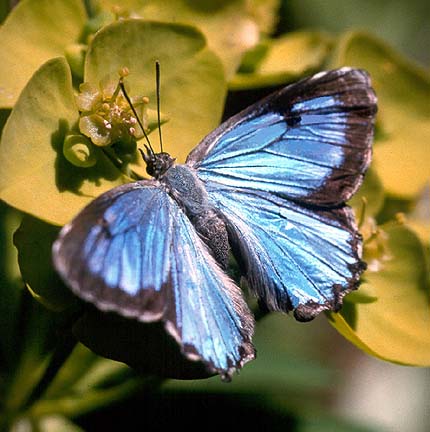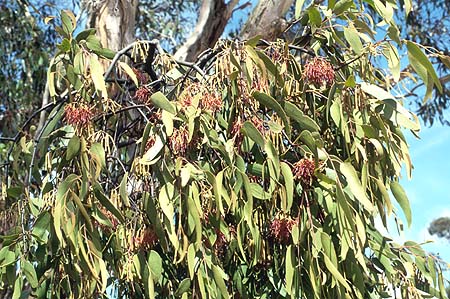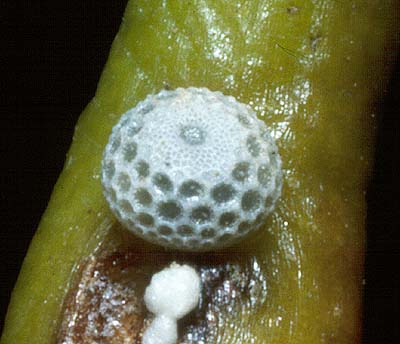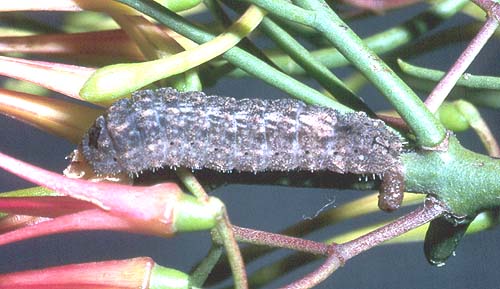-
Larval Food Host
-
The larvae feed on many types of Amyema mistletoe,
including Amyema fitzgeraldii (pincushion mistletoe),
A. gibberula var. gibberula (grevillea-hakea mistletoe),
A. linophylla orientale (bulloak or buloke mistletoe),
A. maidenii maidenii (pale-leaf mistletoe),
A. melaleucae (melaleuca mistletoe),
A. miquelii (box mistletoe),
A. miraculosa boormanii (fleshy mistletoe),
A. pendula pendula (drooping mistletoe),
A. preissii (wire-leaf mistletoe),
A. quandang var. quandang (grey mistletoe),
A. sanguinea (bloodwood mistletoe) (Loranthaceae).
The larvae normally eat the flower buds, flowers, leaves and soft stem parts of
the host mistletoe, but are particularly fond of the flower buds.They will also
eat green fruits if other parts of the hostplant are in short supply. The coastal
Queensland subspecies (hewitsoni) of the butterfly has recently been seen
to use Diplatia furcata mistletoe as a hostplant. This mistletoe is not
present in South Australia, although a related mistletoe Diplatia grandibractea
(Coolibah Mistletoe) occurs on riverine Eucalypts in northern SA, except
the local subspecies of the butterfly is not known to utilise this mistletoe.
In temperate areas the female butterfly has a preference for certain
mistletoes on which to lay her eggs.
The melaleuca and wire-leaf mistletoes are at the top of the list, followed by the
second preference fleshy, grey, pale-leaf and pincushion mistletoes, while the
remaining mistletoes of the above food-host group are the least preferred.
In the Far North of the state, the females are happy to lay on any
Amyema mistletoe, although on one high hilltop that had both
Amyema miquelii (on Eucalyptus) and Amyema maidenii (on mulga)
occurring, the larvae were only using the latter host plant. Interestingly, in South
Australia, the endemic Australian Lysiana (Harlequin) mistletoes are toxic to
the larvae. (The Amyema mistletoe is not endemic to Australia.) Although the
females will very rarely lay eggs on A. miquelii in South Australia, the larvae
will readily accept A. miquelii in captivity and often develop much better on
that mistletoe than on the other mistletoes.
-
Larval Attendant Ant
-
Larvae are usually attended by a few small ants including a dark brown
and black Crematogaster sp and different small
Iridomyrmex spp either black or dark brown or
orange and black coloured, and there is likely also a change in ant
shifts at night to include the nocturnal larger sugar ants Camponotus sp.
Interstate the attendant ants include Crematogaster sp (laeviceps group),
Anonychomyrma sp (nitidiceps group),
a black Iridomyrmex sp A (rufoniger group),
Ochetellus sp, Papyrius nitidus, and Podomyrma sp.
-
Eggs
-
Small, blue-white to white, sometimes brownish, hemispherical shape, basally
flattened, the top is domed. The sides are coarsely reticulated in a hexagonal
pattern, with each reticulation intersection having a small raised blunt
projection. The facets on the top of the egg are much smaller and are of
irregular shape and these continue to the small-depressed micropylar area at
the apex of the egg. The eggs are typical for the species-group. Larval
development within the egg is variable, depending on location and time of year.
An egg laid in March in the Coorong area only took five days to hatch. A clutch
of eggs laid in July in the Musgraves in the Far North of the state took 17 days
to hatch. In some areas where the butterflies are common, there are populations
of tiny parasitoid wasps on the mistletoes and many of the eggs suffer parasitisation.
Eggs can be laid singly or in small or large batches, depending on how much time the
female has to lay before being disturbed, or where they are laid on the hostplant.
On the flower buds, leaves and smaller stems of the mistletoe the eggs are usually
laid singly or in pairs, while batches of eggs are laid on the bole (base) and
thicker stems of the mistletoe, and sometimes on adjacent parts of the mistletoe
host. A single cluster of 23 eggs was laid by a female on a flower bud of
A. maidenii in the Far North. Some collective egg batches resulting from
repeat layings by the same or several females can frequently contain more than 50
eggs. In captivity, one female once laid more than 120 eggs over a two week period.
-
Larvae
-
The first instar is pale greyish yellow, later becoming green after eating
the young leaves of the hostplant. Long onisciform shape, with scalloped
lateral edges. The posterior dorso-lateral organs are not developed. The
head is large, smooth, brownish yellow, hidden beneath the body. There
are long dark peripheral and dorsal setae, which are longest anteriorly,
posteriorly and dorsally. Dorsal setae occur in two pairs, one pair being
long and recurved, the other pair being short, recumbent and directed to
the rear. Intermediate instars gradually lose the long dorsal setae and
gain the posterior dorso-lateral organs, and are onisciform (slater shaped).
The second and third instars can be either green or brown coloured, but by
the late third instar stage they are usually all brown coloured. The remaining
two instars are brown coloured.
First and second instar larvae remain exposed on the leaves of the mistletoe
where their colour matches the leaves, but by the third instar as they get
larger and more easily recognisable to predators they will begin to hide
and shelter during the day, and feed at night. The young larvae initially
eat the young tips of the mistletoe, but by about the late third instar they
will also eat the older leaves and flower buds. Older larvae shelter during
the day under coarse old bark near or on the hostplant, or in crevices in
the mistletoe host, or in borer holes or ant tunnels in the mistletoe or
mistletoe host, in bird nests or in other leaf debris caught up in the
mistletoe or near the hostplant. These older larvae will aggregate together
if the shelter is large enough. Sometimes the places to hide on the mistletoe
and mistletoe host are inadequate, and larvae will then shelter in debris
around the base of the host, or even inside ant tunnels and ant nests at the
base of the host tree. The numbers of larvae feeding on a mistletoe that is
being utilised by the butterflies are variable, usually depending on the size
and health of the mistletoe, and whether there are good hiding places present
for the larvae. The numbers vary from just a few larvae, to one extreme case
encountered in WA of some 200 larvae.
The fifth (final) instars are about 21-27 mm long, onisciform shaped with a
thoracic dorsal furrow, the lateral edges are scalloped, the anterior and
posterior areas are flattened, and there are some short peripheral hairs that
are longer anteriorly and posteriorly. Generally brown coloured,with pale
yellow dorsal chevron markings and other subdorsal markings, a pale yellow
longitudinal subdorsal line, the anterior and posterior extremities are usually
free of pale markings, and the spiracles are black. The prothoracic plate is
dark brown, divided by a pale median line, the anal plate is pale coloured
divided by a dark I shaped median mark. The body is covered in brown, black or
white coloured, minute secondary setae, which are recumbent, club shaped and
rough in appearance, set on a protuberant,angular and ridged base. The secondary
setae impart a scabrous appearance to the larvae. The posterior dorso-lateral
organs are well developed. The head is small, smooth, brown in front, yellowish
laterally, hidden beneath the body.
Larvae normally take five instars to fully develop, but sometimes they will take
more although this is sometimes indicative of the larvae having physiological
problems, due probably to waste chemicals affecting the environment.
-
Pupae
-
Short cylindrical, rounded anteriorly and posteriorly, about 13-16 mm long.
Normally coloured in some shade of brown, usually in a pale shade, (rarely
very dark brown as in O. olane),
with a darker dorsal line, and other darker cryptic markings. However, they
can be nearly black when the rare pupation occurs during winter. There is a
pair of large, dark brown dorsal spots above the head. The surface of the pupa
is without hairs, but bears a reticulated pattern (similar to the eggs) that
produces a very fine scabrous surface, and which includes minute specialised
secondary setae that are more common around the spiracles. Pupation normally
occurs in the final larvae shelter, often well away from the mistletoe towards
the base of the mistletoe host tree where coarse flaking (but secure) bark and
other places to hide are more prevalent. Larvae will often pupate gregariously
together, and large colonies of pupae are known if a suitably large shelter is
present. Larvae will also pupate in the positions of previous pupae (from which
the adult butterflies have previously emerged), by first destroying the empty
pupal shells. Pupae are attached to the silked substrate by anal hooks and a
central girdle.
The pupa development period is variable, depending on the location and time of
year, but as for all butterflies the pupal period becomes shorter as the average
day temperature increases. In temperate areas, it takes 40-55 days for the pupa
to develop in mid winter, in early spring 36-44 days, in late spring 19-22 days,
in summer 13-15 days, in mid autumn 19-20 days, and in early winter about 31 days.
Like most of the Ogyris butterflies, emergence of the butterfly from the
pupa is rapid, and on a hot day it is flying within 1/2 an hour, sometimes even
less. The butterflies usually emerge in the morning, and will emerge earlier if
there has been an overnight dew and the day is hot. Like many Lycaenidae that are
attended by ants, but particularly for many of the Ogyris, the butterflies
emerge with the body covered in large quantities of fluffy grey 'down', which is
discarded when the butterfly first flies. This down helps protect the butterfly
from being attacked by over-zealous attendant ants, or even other small predators
while the butterfly is expanding and hardening its wings in readiness for first flight.
The pupae are known to stridulate, making a series of audible clicks, which are
believed used as a means of communicating with the attendant ants. There is
usually at least one ant in attendance with a pupa.
-
Flight Period in South Australia
-
Flight is very much dependent on the area in which the butterfly occurs.
Main flights tend to coincide with the flowering of the mistletoe
hostplants, which are used for nectaring purposes by the adults.
In the temperate areas there are continuous broods over the warmer months,
which can be completed in about 10 weeks, although there is usually a main
emergence in summer, and lesser flights in spring and autumn. Larvae can go
into a torpid (semi-hibernation) state over winter in very cold areas,
although in temperate areas larvae will also develop very slowly over winter.
Males will emerge earlier than females from a single clutch of eggs. In hot
temperate and southern pastoral areas the main flights are usually in spring
and autumn. In the hot Far North of the state they can fly all year round,
but tend to be more common during the cooler months especially during the
period when their mistletoe hostplants are in flower.

-
Distribution
-
The species is found through most of mainland Australia wherever its
hostplants occur, but is yet to be found on Kangaroo Island even
though one of its hostplants is present. Interestingly, only
Amyema melaleucae occurs on Kangaroo Island and southern
Eyre Peninsula. Separate subspecies of the butterfly occur in the
tropical north of Australia, and in the eastern states.
The butterfly can tolerate most habitats, from the hot humid tropics,
the hot arid areas, to even areas with winter snow (ACT). The unusual
form parsonsi of the butterfly is sometimes produced in captivity
when immature early stages of the butterfly collected from northern
South Australia are reared in cool southern areas during the cold months.
Otherwise the latter butterfly is more commonly seen flying at higher
elevations of the Central Australian ranges, where they can also be much
larger to 44 mm.
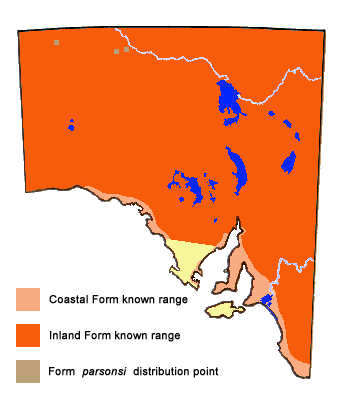
-
Habitat
-
Usually found wherever its Amyema mistletoe hostplants occur, and these
are common and widespread occurring in most habitats. It prefers open shrub
and woodland habitat on the drier side.
-
Conservation Status in South Australia
-
It can be a common butterfly when in flight. Rare in the Lower Southeast
Region of the state.
-
Threats
-
Not generally under threat except in larger urban areas, where its mistletoe
hostplants are usually considered pests and often removed from their hosts.
-
Conservation Strategy
-
In urban areas a public education process
is required for the Amyema mistletoe. Healthy trees are able to support this
mistletoe, and there is usually a self-induced balance between the tree host and the
mistletoe. If there appears to be an imbalance then it should not be a problem to
thin out some of the mistletoe. An active Ogyris colony will help keep the
mistletoe pruned. Harlequin mistletoe (Lysiana sp) can be invasive and this
mistletoe should not be confused with the Amyema mistletoes.




